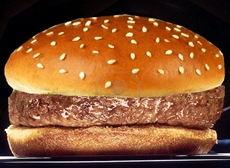World’s first artificial burger tastes ‘almost like the real thing’
06 Aug 2013
One might expect a hamburger costing around Rs2 crore to be something special; but this one tasted like any ordinary burger – except perhaps that it was a little on the dry and under-flavoured side.
 The burger was artificial, manufactured from cow stem cells in a laboratory – and something that was till recently considered as the product of a sci-fi writer's imagination could now be only 10 years away from commercial production.
The burger was artificial, manufactured from cow stem cells in a laboratory – and something that was till recently considered as the product of a sci-fi writer's imagination could now be only 10 years away from commercial production.
The synthetic burger was unveiled at a conference in London on Monday, where it was tasted in public by two well-known gourmets who are also popular in the media.
Google co-founder Sergey Brin was a major financer of the project.
Mark Post, whose team at Maastricht University in the Netherlands developed the burger, hopes that making meat in labs could eventually help feed the world and fight climate change.
Breeding animals for meat is now well known to be resource-intensive and environmentally destructive, apart from being inhumanly cruel.
Monday's taste test, coming after five years of research, is a key step toward making lab meat a culinary phenomenon.
"For the burger to succeed it has to look, feel and taste like the real thing," Post said.
Post and colleagues made the meat from the muscle cells of two organic cows. The cells were put into a nutrient solution to help them develop into muscle tissue, growing into small strands of meat.
It took nearly 20,000 strands to make one 140-gram (5-ounce) patty, which for Monday's taste test was seasoned with salt, egg powder, breadcrumbs, red beet juice and saffron. The project cost €250,000 ($332,000, or Rs2 crore).
"I'm a vegetarian, but I would be first in line to try this," said Jonathan Garlick, a stem cell researcher at Tufts University School of Dental Medicine in Boston. He has used similar techniques to make human skin but wasn't involved in the burger research.
Experts say new ways of producing meat are needed to satisfy growing carnivorous appetites without exhausting resources.
By 2050, the UN Food and Agriculture Organization predicts that global meat consumption will double as more people in developing countries can afford it. Raising animals destined for the dinner table takes up about 70 per cent of all agricultural land.
The animal rights group PETA (People for Ethical Treatment of Animals) has thrown its support behind the lab-meat initiative.
"As long as there's anybody who's willing to kill a chicken, a cow or a pig to make their meal, we are all for this," said Ingrid Newkirk, PETA's president and co-founder. "Instead of the millions and billions (of animals) being slaughtered now, we could just clone a few cells to make burgers or chops."
Google's Brin did not get the chance to taste the first synthetic meat to be cooked and eaten in public. That honour of eating the five-ounce patty of cultured meat went instead to two independent food writers.
It tasted ''close to meat'', but was not as juicy, and although it looked and cooked like the real thing, it felt too crunchy on the surface and lacked taste in the middle, they said after sampling the meat at a west London venue.






















